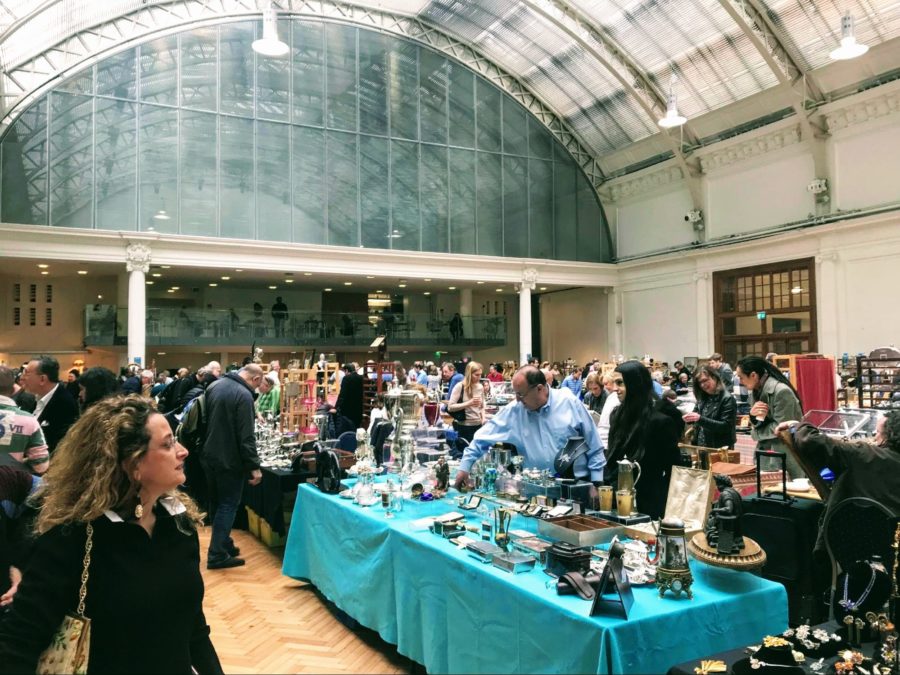
What is an antiques experience?
An experience is something that you can book online, where you have a chance to explore some element of the local culture within a small group, through the eyes of a local host, who is an expert, teacher, guide or enthusiast in the subject area. Locals as well as tourists go along, as its a great way to meet people and to learn new skills.
I went along for the Explore Top Art and Antique Fairs Experience in London hosted by the charming and knowledgable Roberta Faccio of ArtWit who is Italian; and has lived in London for 13 years.
She was born into a family of Antique lovers and collectors; and would frequently visit UK antique fairs with her family as a child.
We visited The Adam’s Antique Fair in London, at The Royal Horticultural Hall in London’s Victoria.
With over 100 regular exhibitors, this is one of the more prestigious fairs. Here is Roberta welcoming us to the experience, and sporting her own antique handbag and Victorian earrings; a gift from her parents.Roberta starts by introducing herself. She is a city economist by trade, but is extremely passionate about antiques, arts and architecture.
She loves antiques because of what they can teach us about people in the past. She is often surprised by how modern they were, and is sometimes startled by the differences also.
She sees collecting antiques as a way of bringing beauty and elegance into the home.
Roberta is teaming with knowledge, tips and enthusiasm.
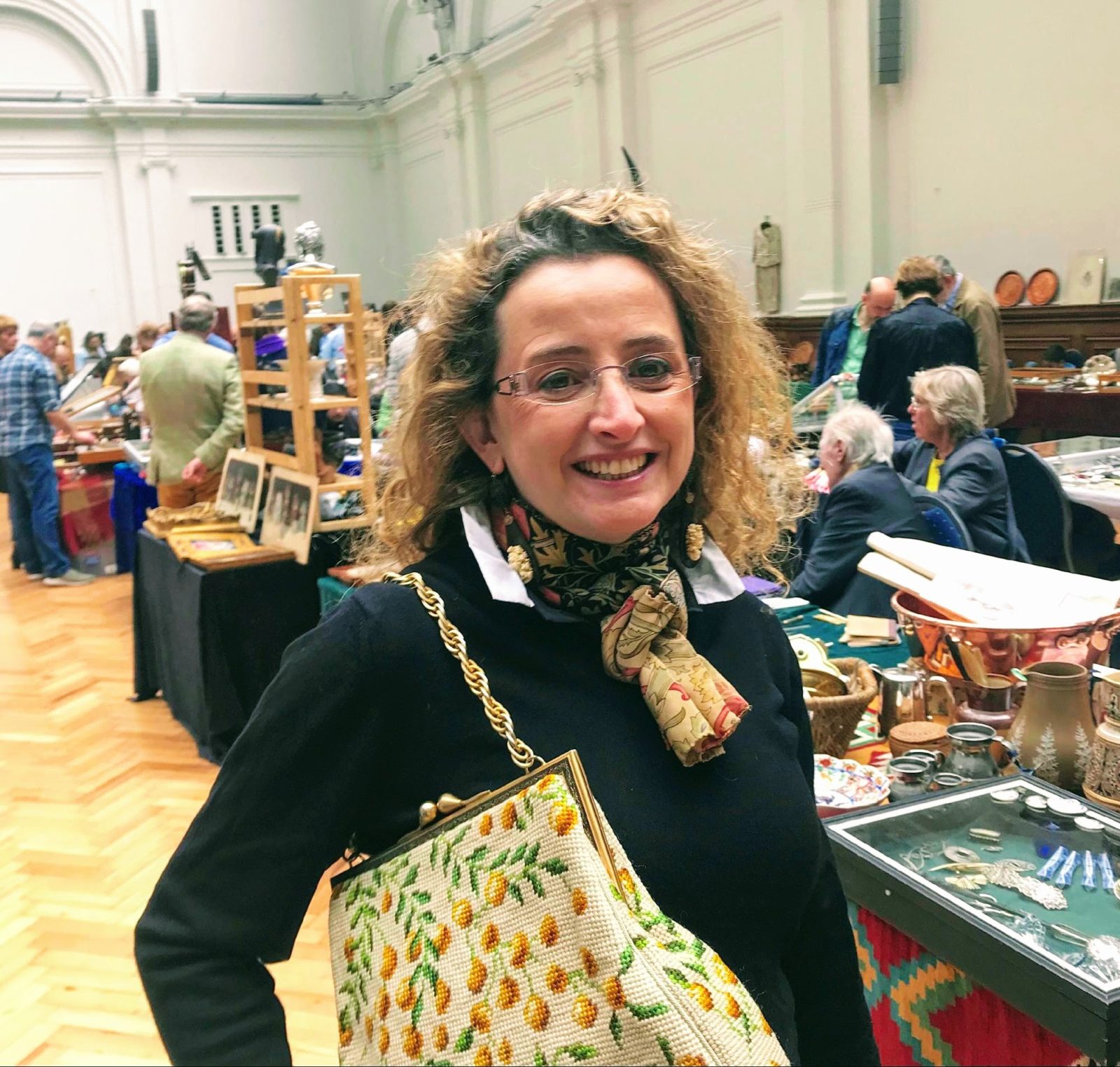
The experience lasts around 2 hours depending on the event. The group explore the fair together, with guidance and tips from Roberta, before going for a cuppa at the venue at the end.
Roberta has a look around before the small group arrives. She finds some items that relate to her personal interests, and interesting themes and trends. When you arrive she asks you about your own interests.
The group then decides upon 3 or so objects to find as a springboard into exploration. Roberta explains that we will travel around and speak to the dealers, and ask them about these objects, their manufacture, how they have been used in different environments and so on, and she shares her own knowledge.
In her introduction Roberta, mentions that they have a wide variety of fairs at the venue; and that Adam’s Antiques exhibitors tend to specialise more in everyday objects, and jewellery. However as we browsed we found a spattering of furniture, and other items also. She also teaches you a little about the fairs history.
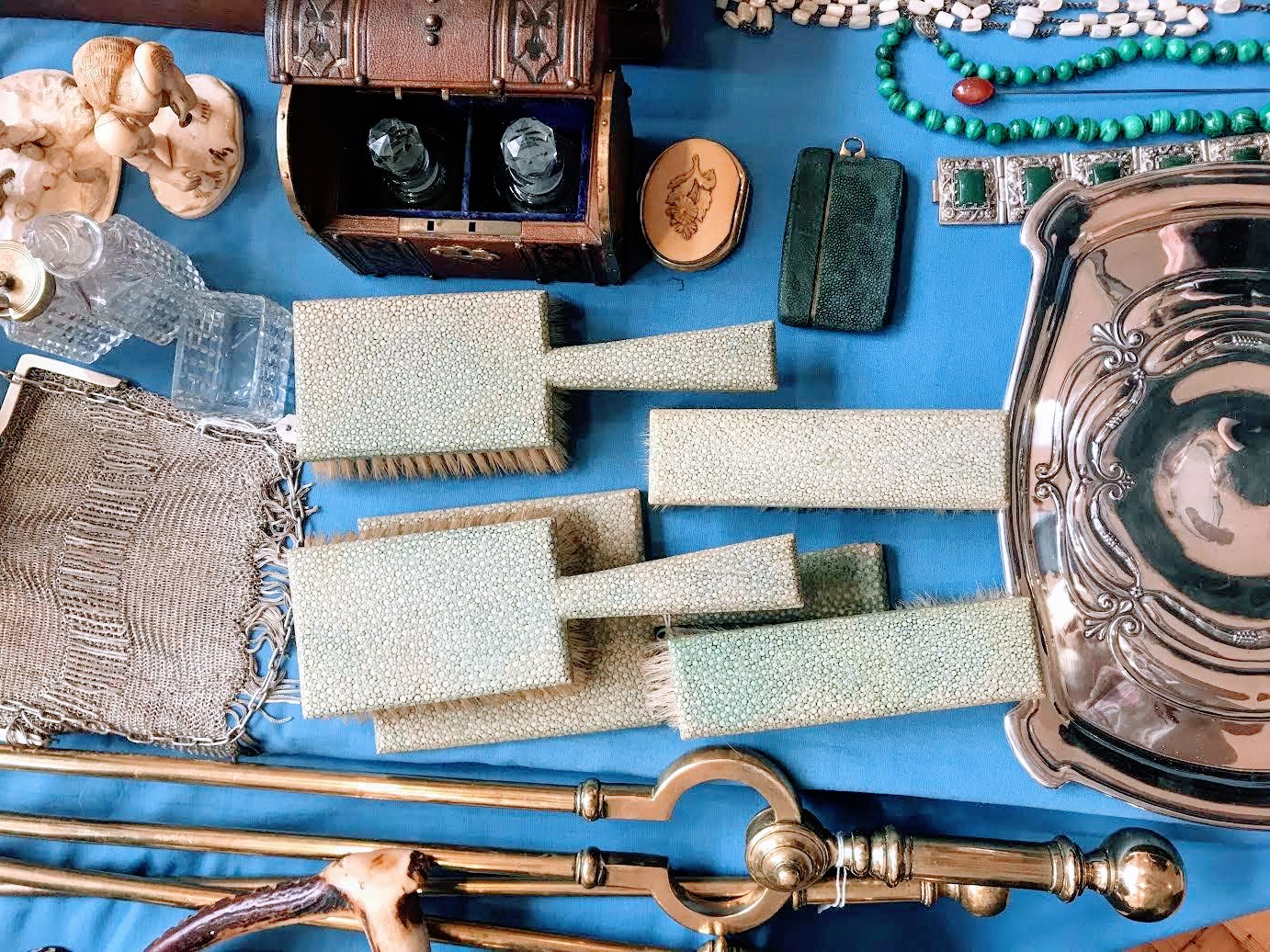
Mr Adams graduated in the 1970s, in art and fine art, before travelling the world and starting to collect. He returned to London; and started to sell the things that he had purchased on his travels.
He set up his first market in the 1980s and started to form strong partnerships with other fairs such as BADA. Today the UK is one of the most prestigious antique market places in the world, together with being the most important art market.
Roberta passionately enthuses that you can see and feel there is a great atmosphere; informing us that when she arrived, people were leaving with big bags of goods. This suggests to her that dealers also buy at the event wholesale for dealerships across Europe, as well as the general public.
She highlights her earring and states that they originated in UK; but were bought in Italy. So it is perfectly possible that the dealer that her mother purchased from in Milan, bought them at this, or an event like this, for their Milan shop.
Roberta explains that it is very important to follow your personal passions as an entry into the world of exploring antique fairs.
She herself is very fond of opera. So we look at theatre glasses as one of our items. I was keener on jewellery.
So we decide to look at theatre glasses, jewellery, and glassware: one of her areas of expertise. She particularly loves glass, because of how objects change depending on the light. She love Art Deco glass for the wider range of colour. She explains how changing technology allowed glass makers to be more diverse in their choices in Art Deco design.
She also talked about the liberty style that emerged around 1900, and especially likes the glass objects that emerged around the first 30 or 40 years of the 20th century.
We begin at a stall with a range of theatre glasses. Roberta begins by asking the dealer about differences between the different items and what era they are from. We learn that the items, (pictured below) are mostly from around 1900 to 1910. That they vary in quality and price. The dealer highlights her best pair, which she agrees to knock down to £100 for us.
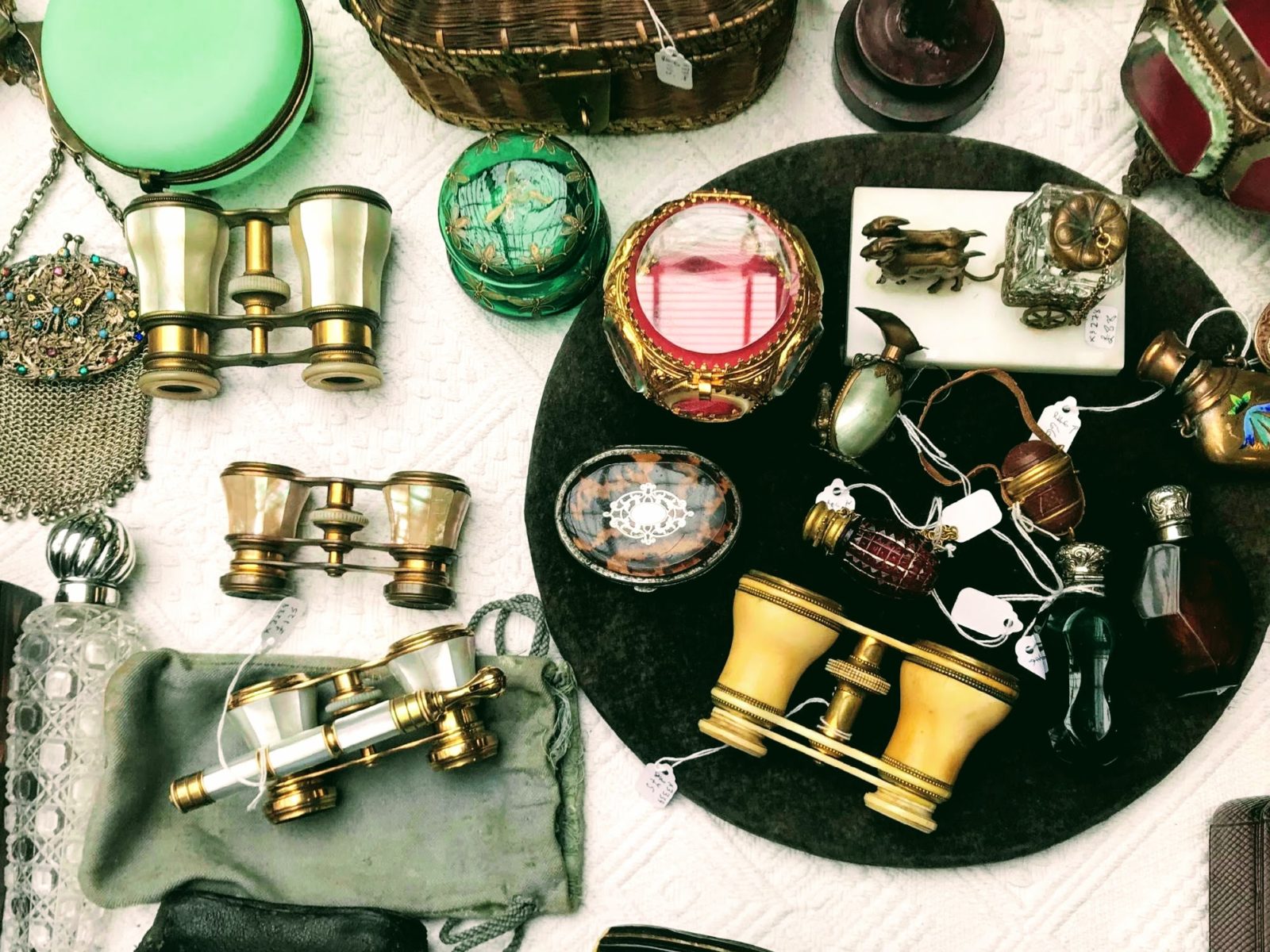
Trust is an important part of the process I learn instinctually, and from Roberta as we browse. I somehow feel that I trust the integrity of this first theatre glass dealer a great deal. She admits to us early on that she had noticed after buying one of her pairs, that they had a little hole in one of the lenses, but that they work perfectly optically. It was not easily noticeable, and she had reflected this in her pricing. I liked that she mentioned this.
Roberta throws in tips for recognising the ages of certain items for yourself, as well as taking the dealers word for it. For example on examining a bowl, she asks the dealer how old it is, and they respond that it is from the 1930s/40s. Roberta goes on to explain that this is a trustworthy response as the mark upon the bottom says: ’Made in England’. She explains that prior to the 1930’s it would have simply said ‘England’.
She informs me that some items and materials are easier to date than others. Glass for example is harder to validate by eye without chemical lab analysis, so its really much more down to trusting the dealer.
However, there are some tell tale signs with glass she explains. For example certain colours were harder to achieve at certain periods in history, certain shapes can be a tell tale sign, and the material shouldn’t be to pure, or transparent.
Returning to our theatre glasses. Roberta explains to the dealer that we have just arrived and that we will look around first. She explains to me afterwards that she is in the market for a pair, but will go away and research and taker her time. We see several pairs throughout the fair and compare.
Adam’s has a wide range of jewellery on offer. From rare, ornate 18th century gold earrings worth many thousands of pounds, to far cheaper, but equally interesting early to mid century costume jewellery. Roberta purchased a 1930s ceramic and plastic necklace.
Pictured here is Gary Monday from Mostly Boxes Antiques showing us around a ZOGRASCOPE from around 1780. This is an item which you would have found in a gentleman’s library for viewing picture. He informs us that it is English, the best one he has seen. And on account of a small missing bolt , a lot more reasonably priced than usual at £750, as opposed to the usual price tag of around £2000-2500.
I made a small purchase, spending only £20, on a blacksmith made, rack of coat hooks, a film prop, from on of the old London film studios originating from the 1920s/1930s.
We didn’t discover a great deal of art, another of Roberta’s interests. But we did find a couple of impressive sketches , some embroidery, and some impressive glass paintings of historical interest from around 1801 depicting the tale of a Spanish battle. The dealer informed us that glass painting was a fashion at around that time as it would have lit up and sparkled in candle light.
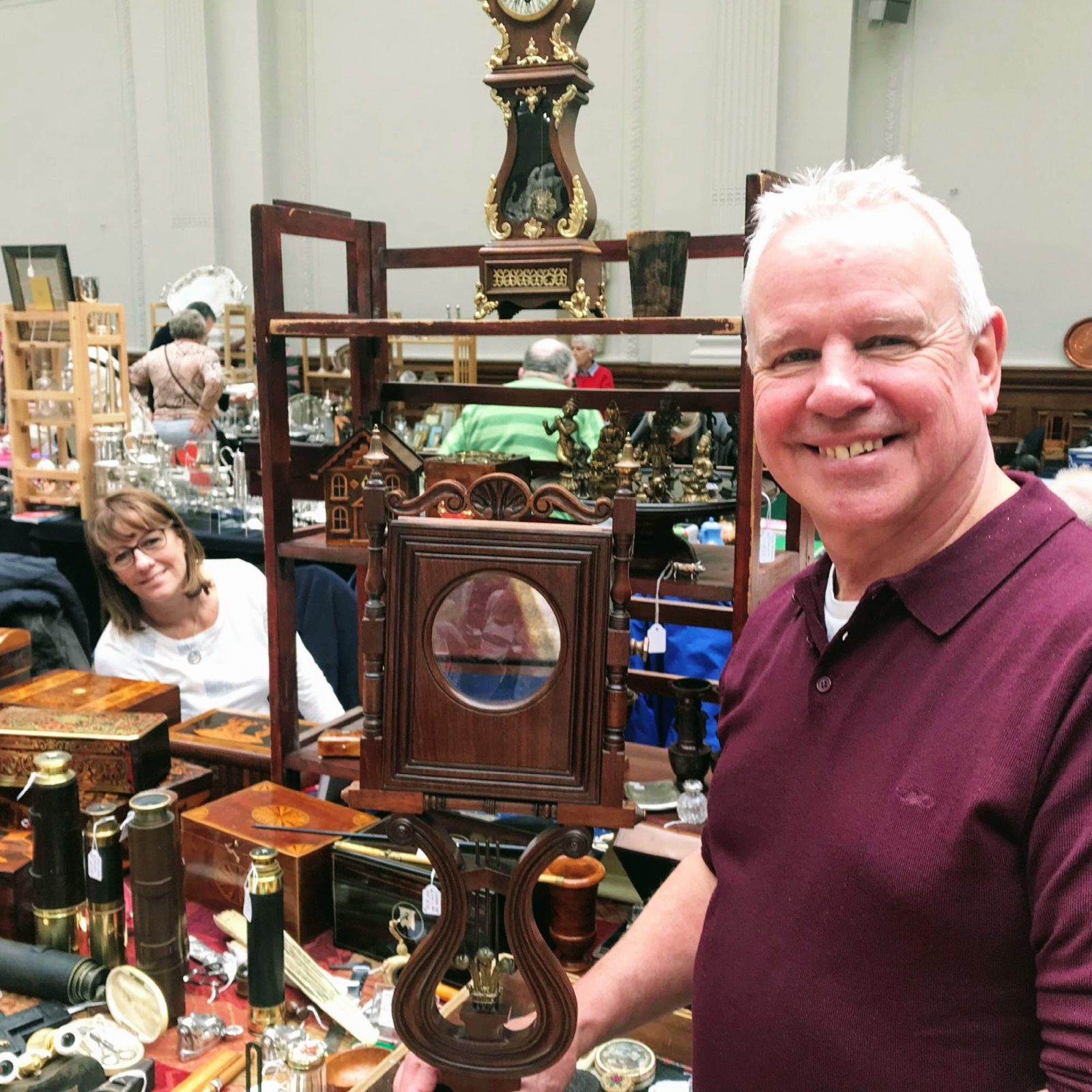
My personal highlight was discovering Carol Tresor’s stall of antique sunken pottery excavated from the South China Sea.
Carol sells to clients all over the world on eBay, and this was her first fair.
A number of her carefully validated pieces, come from the famous Hoi An shipwreck; which spent 600 years under the sea before fishermen discovered pots in their nets, 22 miles off the coast of Vietnam.
There is a fascinating book on the subject Dragon Sea by Frank Pope; all about the Hoi An adventure, and other dives for underwater antiquities. Highly recommended if you are interested in the subject, or just fancy a gripping read.
Carol explained to us that many of the pots have traces of black, the result of fire, and crustaceans, but that many of the pots remained eerily intact for centuries buried in the sea bed, giving insight into lost history.
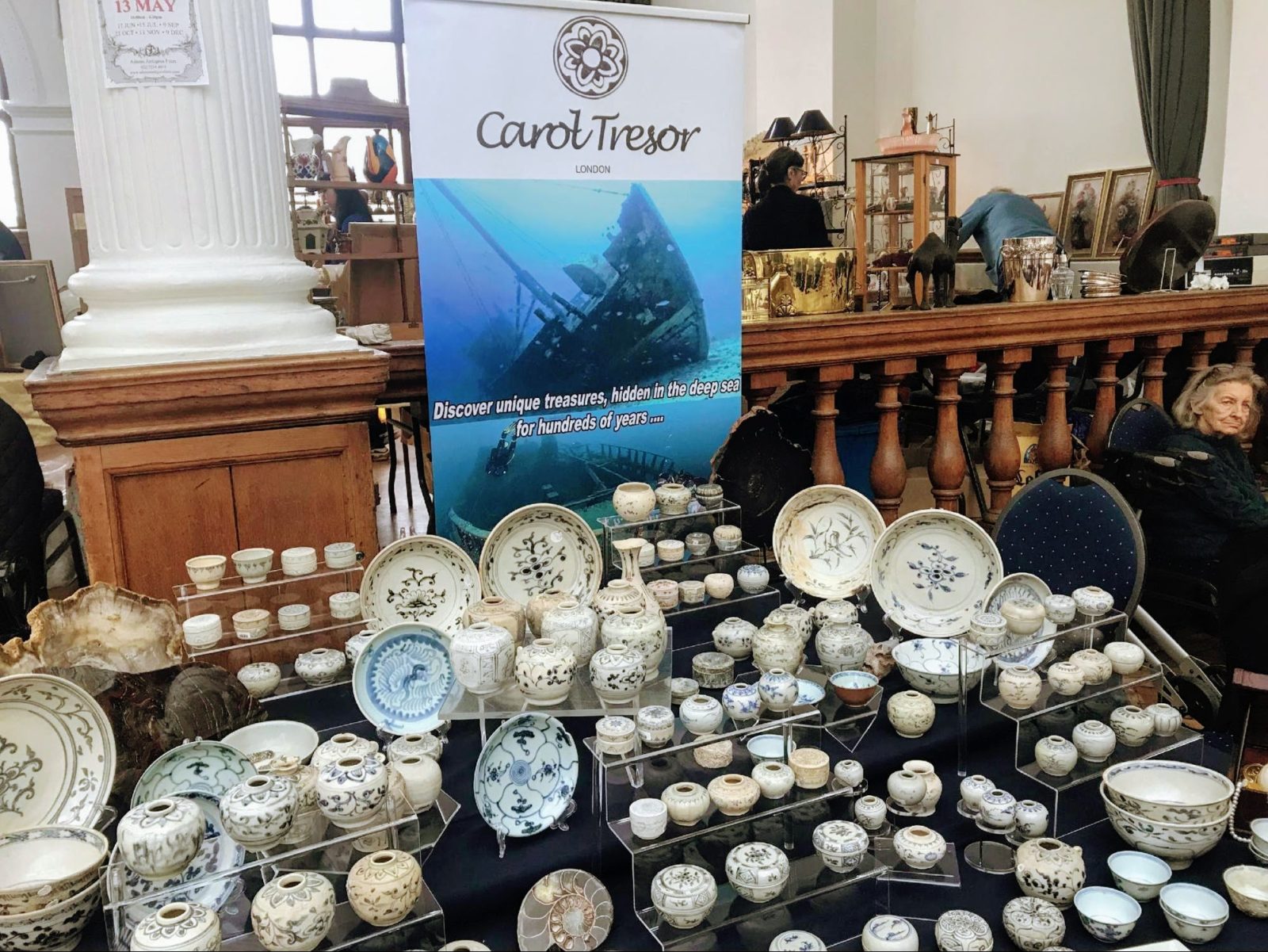
We found a spattering of furniture at the fair, such as a lovely Edwardian, swivelling music chair for playing the Cello or Harp. Unfortunately the dealer didn’t know a great deal about it, but thought that it was probably turn of the century.
An unrivalled selection of antique bedroom furniture.
| Cookie | Duration | Description |
|---|---|---|
| cookielawinfo-checbox-analytics | 11 months | This cookie is set by GDPR Cookie Consent plugin. The cookie is used to store the user consent for the cookies in the category "Analytics". |
| cookielawinfo-checbox-functional | 11 months | The cookie is set by GDPR cookie consent to record the user consent for the cookies in the category "Functional". |
| cookielawinfo-checbox-others | 11 months | This cookie is set by GDPR Cookie Consent plugin. The cookie is used to store the user consent for the cookies in the category "Other. |
| cookielawinfo-checkbox-necessary | 11 months | This cookie is set by GDPR Cookie Consent plugin. The cookies is used to store the user consent for the cookies in the category "Necessary". |
| cookielawinfo-checkbox-performance | 11 months | This cookie is set by GDPR Cookie Consent plugin. The cookie is used to store the user consent for the cookies in the category "Performance". |
| viewed_cookie_policy | 11 months | The cookie is set by the GDPR Cookie Consent plugin and is used to store whether or not user has consented to the use of cookies. It does not store any personal data. |